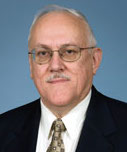 Abstract: In this talk, we present a novel multiscale moving contact line (MMCL) theory, which offers a powerful numerical simulation method for modeling and analysis of dynamic wetting, liquid droplet spreading on solid substrates, and various capillary motion phenomena. In the proposed multiscale moving contact line theory, we couple molecular scale adhesive interaction i.e. the van der Waals type interaction force and the macroscale fluid mechanics to solve droplet motions on solid substrates. In specific, we combine a coarse-grained adhesive contact model with a modified Gurtin-Murdoch surface hydroelasto-dynamics theory and the Navier-Stokes equation in the bulk fluids to formulate the multiscale moving contact line hydrodynamics theory in order to simulate a broader class of colloidal and soft matter physics phenomena, and related chemomechanical problems, such as cell motility, water spider walking, colloid suspension, and gas bubble in water, etc.
Abstract: In this talk, we present a novel multiscale moving contact line (MMCL) theory, which offers a powerful numerical simulation method for modeling and analysis of dynamic wetting, liquid droplet spreading on solid substrates, and various capillary motion phenomena. In the proposed multiscale moving contact line theory, we couple molecular scale adhesive interaction i.e. the van der Waals type interaction force and the macroscale fluid mechanics to solve droplet motions on solid substrates. In specific, we combine a coarse-grained adhesive contact model with a modified Gurtin-Murdoch surface hydroelasto-dynamics theory and the Navier-Stokes equation in the bulk fluids to formulate the multiscale moving contact line hydrodynamics theory in order to simulate a broader class of colloidal and soft matter physics phenomena, and related chemomechanical problems, such as cell motility, water spider walking, colloid suspension, and gas bubble in water, etc.
The advantage of adopting the coarse grain adhesive contact model in the moving contact line theory is that it can levitate and separate the liquid droplet with the solid substrate, so that the proposed multiscale moving contact line theory avoids imposing the non-slip condition, and then it removes the subsequent shear stress singularity problem, which allows the surface energy difference and surface stress propelling droplet spreading naturally.
We have also developed a soft matter model for biological cells that can model actin polymerization and ATP hydrolysis, and retrograde flow in cellular lamellipodia. By employing the MMCL method, we have successfully simulated cell durotaxi over the soft elastic substrates with non-uniform elastic stiffness. By employing the proposed method, we have successfully simulated droplet spreading over various elastic substrates and cell durotaxi over the substrates with non-uniform elastic stiffness. The obtained numerical simulation results compare well with the experimental and molecular dynamics results reported in the literature.
Biographical Sketch: Dr. Shaofan Li is currently a full professor of applied and computational mechanics at the University of California-Berkeley. Dr. Li graduated from the East China University of Science and Technology (Shanghai, China) with a BS degree in 1982; he also holds MS Degrees from both the Huazhong University of Science and Technology (Wuhan, China) and the University of Florida (Gainesville, FL, USA) in 1989 and 1993 respectively. In 1997, Dr. Li received a PhD degree from the Northwestern University (Evanston, IL, USA), and he was also a post-doctoral researcher at the Northwestern University during 1997-2000. In 2000, Dr. Li joined the faculty of the Department of Civil and Environmental Engineering at the University of California-Berkeley. Dr. Shaofan Li is the recipient of IACM Fellow Award [2017]; Distinguished Fellow Award of ICCES [2014]; ICACM Computational Mechanics Award [2013], USACM Fellow Award (2013), A. Richard Newton Research Breakthrough Award [2008], and NSF Career Award [2003]. Dr. Li has published more than140 articles in peer-reviewed scientific journals (SCI) with h-index 43 (Google Scholar), and he is also the author of two research monographs/graduate textbooks.

 The talk will focus on two themes. The first will be an overview of our current ARPA-E project to condense water from flue gas for dry-cooled power plants power plants. Water use by power plants is an increasing concern across the U.S., and is particularly problematic in arid regions, such as the southwest. In this project, an advanced two-phase thermosyphon concept is employed that removes several of the traditional limitations of conventional thermosyphons. The condensed water can be used to pre-cool the condenser air to reduce the effective ambient temperature, for turbine inlet air evaporative cooling, or for other uses in the plant, as needed. The second portion of the talk will provide a short overview of other energy-related research activities in the Mechanical Engineering department at Stony Brook University with the goal to explore future opportunities for collaboration and joint projects between both institutions.
The talk will focus on two themes. The first will be an overview of our current ARPA-E project to condense water from flue gas for dry-cooled power plants power plants. Water use by power plants is an increasing concern across the U.S., and is particularly problematic in arid regions, such as the southwest. In this project, an advanced two-phase thermosyphon concept is employed that removes several of the traditional limitations of conventional thermosyphons. The condensed water can be used to pre-cool the condenser air to reduce the effective ambient temperature, for turbine inlet air evaporative cooling, or for other uses in the plant, as needed. The second portion of the talk will provide a short overview of other energy-related research activities in the Mechanical Engineering department at Stony Brook University with the goal to explore future opportunities for collaboration and joint projects between both institutions. The U.S. Army Research Laboratory (ARL) was activated 25 years ago with a mission to discover, innovate and transition science and technology to ensure dominant strategic land power. One of key research strategies at ARL is a development of superior protection systems for individual warfigter and vehicles. The protective systems often use polymers due to their low weight, good strength and toughness which improves resistance to ballistic penetration.
The U.S. Army Research Laboratory (ARL) was activated 25 years ago with a mission to discover, innovate and transition science and technology to ensure dominant strategic land power. One of key research strategies at ARL is a development of superior protection systems for individual warfigter and vehicles. The protective systems often use polymers due to their low weight, good strength and toughness which improves resistance to ballistic penetration. Abstract: This presentation is focused on Isogeometric Analysis (IGA) with applications to solids and structures, starting with early developments and results, and transitioning to more recent work. Novel IGA-based thin-shell formulations are discussed, and applications to progressive damage modeling in composite laminates due to low-velocity impact and their residual-strength prediction are shown. Fluid–structure interaction (FSI) employing IGA is also discussed, and a novel framework for air-blast-structure interaction (ABSI) based on an immersed approach coupling IGA and RKPM-based Meshfree methods is presented and verified on a set of challenging examples. The presentation is infused with examples that highlight effective uses of IGA in advanced engineering applications.
Abstract: This presentation is focused on Isogeometric Analysis (IGA) with applications to solids and structures, starting with early developments and results, and transitioning to more recent work. Novel IGA-based thin-shell formulations are discussed, and applications to progressive damage modeling in composite laminates due to low-velocity impact and their residual-strength prediction are shown. Fluid–structure interaction (FSI) employing IGA is also discussed, and a novel framework for air-blast-structure interaction (ABSI) based on an immersed approach coupling IGA and RKPM-based Meshfree methods is presented and verified on a set of challenging examples. The presentation is infused with examples that highlight effective uses of IGA in advanced engineering applications.